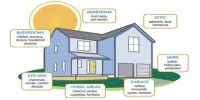A first-of-its-kind comprehensive global dataset of the Earth’s lakes and reservoirs, demonstrating how they have changed over the past 30+ years, has been published by an interdisciplinary team of researchers led by data scientists from the University of Minnesota Twin Cities with funding from NASA and the U.S. National Science Foundation.
The data will give environmental experts new knowledge on how land and fresh water are used, as well as how people and climate change are affecting lakes and reservoirs. The study represents a significant development in machine learning methods.
Scientific Data, a peer-reviewed, open-access journal published by Nature, recently published a study presenting the Reservoir and Lake Surface Area Timeseries (ReaLSAT) dataset.
The availability and quality of surface freshwater is central to sustainable use of our planet. Because ReaLSAT shows changes in lakes and their boundaries, rather than just water pixels across the landscape, we can now connect ecosystem process about water quality with hundreds of thousands of lakes around the world.
Paul C. Hanson
Highlights of the study include:
- The location and surface area fluctuations of 681,137 lakes and reservoirs greater than 0.1 square kilometers (south of 50 degrees north latitude) are included in the ReaLSAT dataset. Only 245,420 lakes and reservoirs have been recognized by the most complete database prior to this one, HydroLAKES, for the region of the world, and the minimum size taken into consideration in this study.
- From 1984 to 2015, ReaLSAT gives information on the surface area of each body of water for each month. In order to fully comprehend how shifting climatic conditions and patterns of land use are affecting freshwater bodies of water, it is essential to be able to quantify changes in lake and reservoir area over time. For each water body, the HydroLAKES data only includes a static shape.
- The result of eight years of study is the ReaLSAT dataset. It marks a significant turning point in the employment of brand-new, knowledge-guided machine learning in the environmental sciences. Unlike prior efforts, this dataset can now be rapidly copied for a range of earth observation data that are becoming available at higher and higher resolutions. It can also be expanded almost automatically through machine learning.
“Around the world, we are seeing lakes and reservoirs changing rapidly with seasonal precipitation patterns, long-term changes in climate, and human management decisions,” said Vipin Kumar, the senior author of the study and Regents Professor and William Norris Endowed Chair in the University of Minnesota Twin Cities Department of Computer Science and Engineering. “This new dataset greatly improves the ability of scientists to understand the impact of changing climate and human actions on our freshwater across the globe.”
A new class of machine learning techniques that combine an understanding of the physical dynamics of water bodies with satellite imagery was needed to build a global dataset of lakes and reservoirs and how they are evolving.
“ReaLSAT is a shining example where environmental challenges motivated a new class of knowledge-guided machine learning algorithms that are now being used in numerous scientific applications,” Kumar said.
Scientists who study the environment agree that ReaLSAT will improve their work.
“The availability and quality of surface freshwater is central to sustainable use of our planet,” said Paul C. Hanson, a Distinguished Research Professor at the University of Wisconsin-Madison Center for Limnology and a co-author of the study.
“Because ReaLSAT shows changes in lakes and their boundaries, rather than just water pixels across the landscape, we can now connect ecosystem process about water quality with hundreds of thousands of lakes around the world.”
NASA grant NNX12AP37G and U.S. National Science Foundation awards 1029711, 1838159, and 1934633 helped to fund the study. The University of Minnesota Supercomputing Institute gave access to computing resources.
















